In the digital age, cultural relevance moves at the speed of a swipe. While cult classics of the past—films like The Rocky Horror Picture Show or Donnie Darko—earned their status over years of underground screenings and word-of-mouth evangelism, the TikTok era has transformed the trajectory of what becomes a “cult classic.” Today, content can achieve cult status in weeks or even days, driven by algorithms, meme potential, and participatory fandom. But what exactly defines a cult classic in the TikTok era, and how does it differ from traditional pathways of cultural canonization?
The Evolution of “Cult Classic”
Traditionally, a cult classic is a work—often overlooked or misunderstood at its release—that gains a devoted following over time. These works typically share certain characteristics: they resonate deeply with a niche audience, provoke strong emotional or aesthetic reactions, and inspire repeated viewings or engagements. They often defy mainstream sensibilities, whether through eccentric storytelling, stylized visuals, or radical themes.
In the TikTok era, however, the definition is broadening. The term “cult classic” is no longer tied strictly to time or medium. A forgotten early-2000s film, a niche indie game, or even a single scene from a TV show can resurface and earn cult status thanks to viral clips, remixes, or reinterpretations on social media.
TikTok’s Algorithm as Cultural Tastemaker
One of the most significant shifts in how cult classics are formed today is the role of TikTok’s algorithm. TikTok doesn’t wait for content to grow slowly—it accelerates exposure. When a piece of content resonates—whether because it’s absurd, nostalgic, emotionally poignant, or unintentionally hilarious—the algorithm pushes it to more users, multiplying its reach exponentially. In effect, TikTok acts as a cultural magnifying glass, amplifying and accelerating what might once have taken years to achieve cult status.
A prime example is the resurgence of the 2004 film Jennifer’s Body, which flopped critically and commercially upon release. In the late 2010s and early 2020s, feminist reinterpretations of the film—often in TikTok video essays, montages, or memes—recast it as a subversive masterpiece. The platform’s remix culture helped transform Jennifer’s Body from a forgotten teen horror movie into a feminist cult classic, almost a decade after its release.
Nostalgia and Rediscovery
TikTok thrives on nostalgia. Millennials and Gen Z users frequently unearth older movies, shows, and songs, recontextualizing them with contemporary sensibilities. These reinterpretations breathe new life into old media. A film like Coraline (2009), originally marketed as a children’s horror film, found renewed cult status as TikTok users explored its dark psychological themes, aesthetics, and fan theories.
This nostalgia isn’t passive—it’s active and participatory. Users edit scenes with new music, act out monologues, or reinterpret characters through cosplay or fan fiction. In this context, a cult classic becomes not just a beloved piece of content but a creative playground for a community of fans.
Memes, Irony, and the Power of the Aesthetic
One of the most potent forces in creating cult status on TikTok is irony. So-bad-it’s-good media thrives on the platform. Movies like Cats (2019) or Twilight (2008) have been memed into ironic appreciation. What was once cringe-worthy becomes endearing; exaggerated acting, bizarre dialogue, or campy visuals become part of the charm. Irony becomes a shared in-joke, turning collective ridicule into affectionate fandom.
Aesthetics also play a significant role. Films and shows with distinctive visual styles—whether that’s the neon gothic of Euphoria or the cozy creepiness of Over the Garden Wall—are especially primed for cult status. A TikTok trend built around a “vibe” or “aesthetic” can bring an entire piece of media back into the spotlight, often divorced from its original context.
Participatory Fandom and Identity Formation
The TikTok era is also defined by how people use media to express identity. Cult classics often resonate because they offer a mirror for marginalized or highly specific identities. TikTok’s format allows users to personalize their engagement with content—making lip-sync videos, reaction clips, or themed makeup tutorials. These forms of expression help people bond with others over shared media tastes, fostering micro-communities that reinforce the content’s cult status.
Take Scott Pilgrim vs. the World (2010), for example. The film’s hyper-stylized editing, gaming references, and alternative music culture have long appealed to a niche demographic. TikTok has helped that niche grow, spawning edits that highlight its aesthetic, music, or quirky quotes. Each viral moment invites more people into the fandom, and the content becomes a touchstone for a particular identity—nerdy, nostalgic, alternative.
The Democratization of Cult Status
Perhaps the most defining feature of the TikTok era is the democratization of what becomes a cult classic. No longer is this status conferred by critics, cinephiles, or academics—it’s granted by everyday users remixing, memeing, and celebrating content on their own terms. In this way, cult classics have moved from underground theaters to digital feeds, from midnight screenings to 60-second clips.
Conclusion
In the TikTok era, a cult classic is less about longevity and more about resonance—how powerfully a piece of media can spark emotion, identity, humor, or creativity within a community. It might come from the past or be born in the moment, but its journey is shaped by virality, aesthetic appeal, and the collective imagination of the internet. As attention spans shrink and content ecosystems grow, the cult classic isn’t dying—it’s evolving. And TikTok is its new breeding ground.

